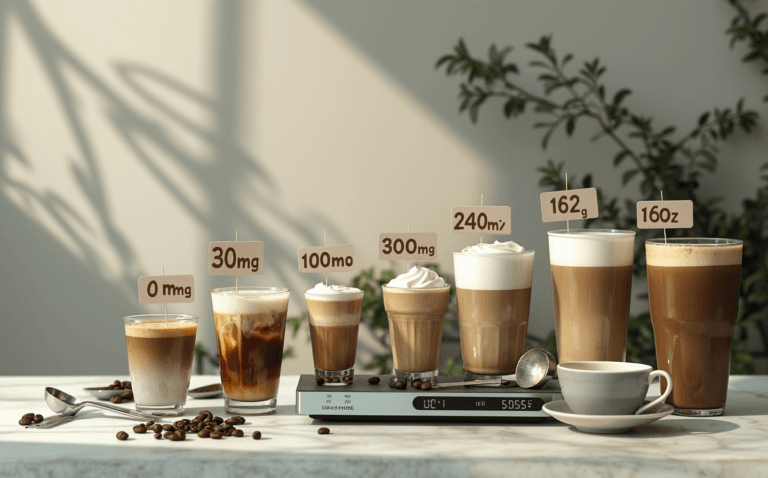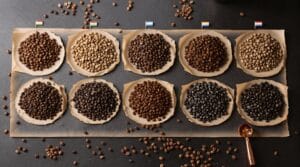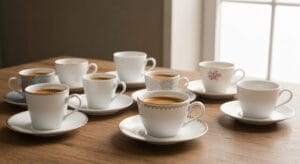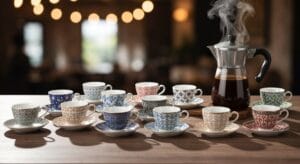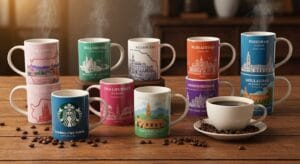Why Tracking Your Caffeine Intake Matters: Sleep Issues and Heart Palpitations
Yesterday, Michael (32) was wide awake until 3 AM. He couldn’t understand why, until he remembered: he had consumed a large cold brew in the afternoon. Michael’s case isn’t uncommon.
According to Samoggia A, Riedel B. (2019) “Consumers’ Perceptions of Coffee Health Benefits and Motives for Coffee Consumption and Purchasing”, Only 16% of U.S. consumers know about coffee’s health benefits, and 66% are prone to limiting their caffeine consumption. This is concerning since 400 milligrams of caffeine is the FDA’s recommended safety threshold.
Why should you care? Because caffeine has two sides:
- Positive: Increased alertness, improved exercise performance, reduced risk of certain diseases
- Negative: Insomnia, anxiety, high blood pressure, and heart palpitations
So how much caffeine are you drinking daily? Is it too much? Let’s find out!
Coffee vs Caffeine: The Numbers You Need to Know
Before diving into details, you need to understand the big picture of caffeine content in popular beverages:
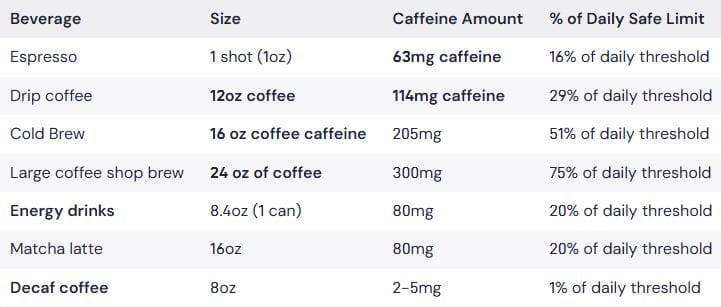
5 Factors That Determine Caffeine Content in Your Coffee
Why does the same “coffee” contain such different amounts of caffeine? Here are 5 reasons:
1. Coffee Bean Type
Arabica contains 1.2% caffeine compared to Robusta’s 2.2%. This means a cup of coffee made from Robusta can contain nearly twice the caffeine.
2. Roast Level
Light roast retains more caffeine due to shorter roasting time. A light roast coffee can contain 15-20% more caffeine than dark roast coffee of the same amount.
3. Brewing Method
The brewing method significantly affects caffeine content:
- Espresso machine (25 seconds): 63mg/shot
- Pour-over (3 minutes): 120mg/6oz
- French Press (4 minutes): 135mg/8oz
4. Cup Size
Serving size is a crucial factor many people overlook:
- Small cup (8oz): 95mg
- Medium cup (caffeine in a medium coffee): 142mg
- Large cup (caffeine in large coffee): 205mg
- Extra-large cup (caffeine in 24 oz coffee): 300mg
5. Brewing Time
Longer steeping = more caffeine. Cold brew steeped for 12-24 hours can contain 205mg in a 16oz cup.
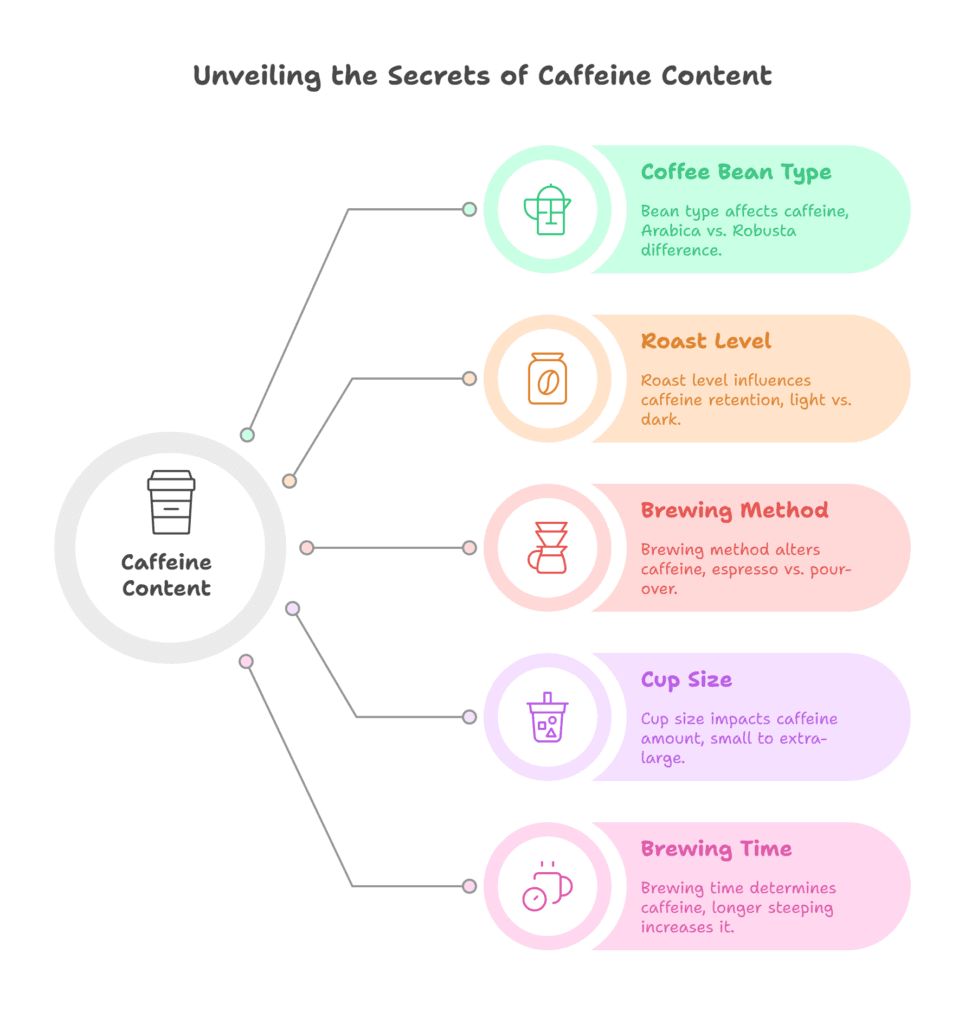
From 1oz Espresso to 24oz Big Cup: Precise Measurement Guide
Let’s look at the exact caffeine content in popular coffee types:
Espresso & Variations
- Espresso caffeine mg (single shot): 63mg
- Double shot: 126mg
- Ristretto: 46mg caffeine
- Lungo: 68mg caffeine
Drip Coffee by Size
- 8oz: 96mg
- Caffeine 12oz coffee: 114mg caffeine
- 16 oz coffee caffeine: 205mg
- 24 oz coffee caffeine: 300mg
Specialty Coffees
- Mocha (6oz): 63mg (1 espresso shot)
- Latte (12oz): 126mg (2 espresso shots)
- Cold Brew (16oz): 205mg caffeine
- Nitro Cold Brew (16oz): 215mg
Comparison With Other Beverages
- 150mg caffeine = 1.5 cups of 8oz coffee
- 160mg caffeine = 2.5 espresso shots
- 180mg of caffeine = 2 cans of Red Bull (8.4oz)
- 300mg of caffeine = 3 medium cups of coffee
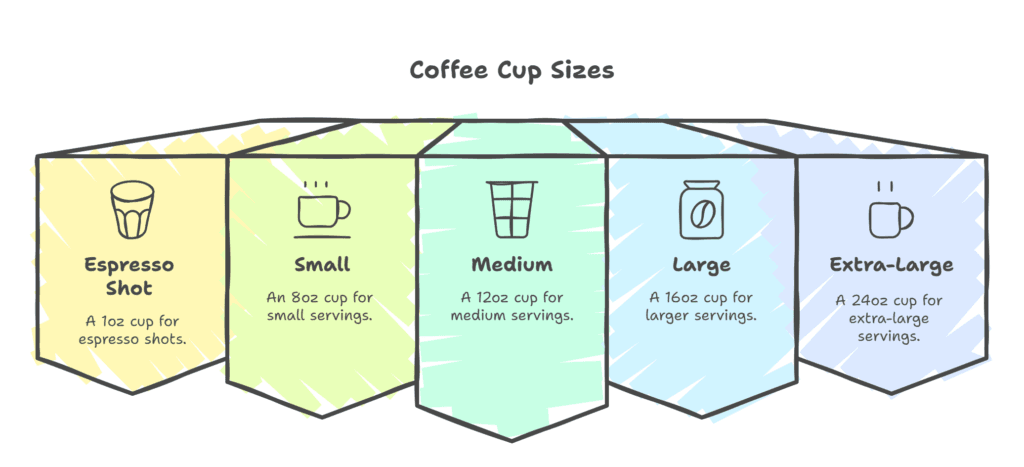
Important note: 80 grams of caffeine is likely a mistake. People typically refer to milligrams of caffeine, not grams (80mg would be reasonable).
How Much is Too Much? Caffeine Limits Based on Your Body
Not everyone reacts the same way to caffeine. Here’s a guide based on sensitivity:
Sensitive Group
If you easily experience rapid heartbeat, anxiety, or insomnia:
- Limit: 100-200mg/day
- Example: Is 66mg of caffeine a lot? For this group, it could be significant!
- Is 76 mg of caffeine a lot? For sensitive individuals – it may cause sleep difficulties if consumed after 4pm.
- Even 68mg caffeine (a lungo shot) could be enough to trigger symptoms in highly sensitive people.
Average Group
Most people fall into this category:
- Safe limit: 300-400mg/day
- Example: 140mg caffeine (a 12oz cup) usually causes no issues
- 189mg of caffeine still falls within the safe range
- A medium drip coffee (114mg caffeine) is perfectly fine for most adults
High Tolerance Group
People who have developed caffeine tolerance:
- Can tolerate: 400-600mg/day
- Note: Even this group should avoid exceeding 400 milligrams (FDA recommendation)
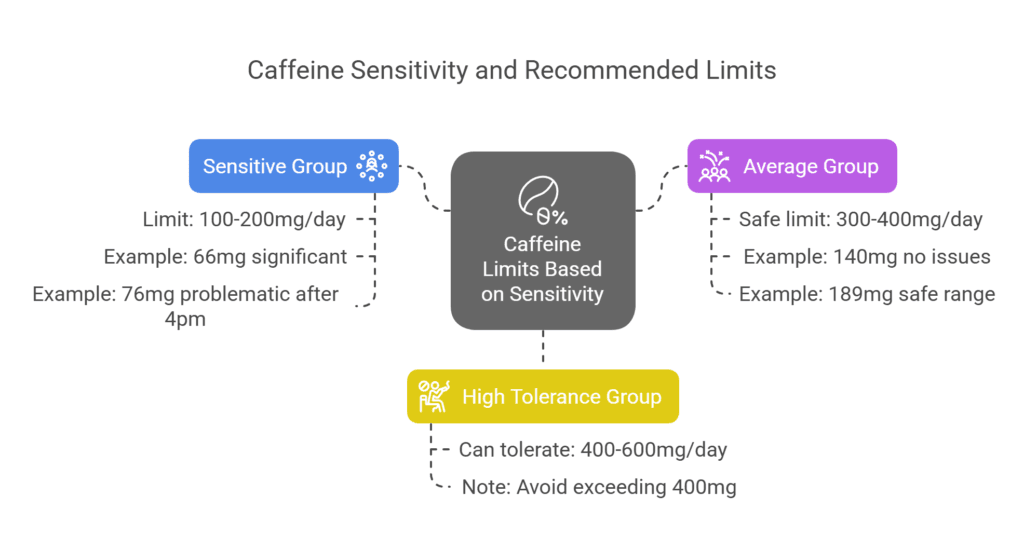
Recommendation: 160mg caffeine how many cups of coffee? About 1.5 cups of standard 8oz size.
9 Frequently Asked Questions About Caffeine (With Surprising Answers)
1. Does espresso have more caffeine than regular coffee?
No! By the ounce, espresso is more concentrated (63mg/oz vs 12mg/oz), but the total amount in 1 shot is less than a regular coffee cup (63mg caffeine vs 114mg caffeine in a 12oz cup).
2. Is cold brew twice as strong as hot coffee?
Not exactly. Cold brew is about 15-30% more concentrated due to longer steeping time.
3. How much is 300 mg of caffeine?
Equivalent to 3 medium-sized cups of coffee (12oz) or 4-5 espresso shots.
4. How much is 140 mg of caffeine?
About 1 cup of drip coffee (12oz) or 1 medium-sized latte.
5. Which caffeinated beverages contain less caffeine than coffee?
Black tea (45-60mg/cup), green tea (25-45mg/cup), and most sodas (35-45mg/can).
6. Is decaf really caffeine-free?
Not true! Decaf coffee still contains 2-5mg caffeine per cup. 10 cups of decaf = 1 regular coffee cup.
7. Is 90mg caffeine a lot or a little?
This is a moderate amount, equivalent to 1 small cup of coffee (8-9oz) or 1.5 espresso shots.
8. Does darker roast mean higher caffeine?
The opposite! The darker the roast coffee, the less caffeine it contains as the roasting process destroys some caffeine.
9. How much is 68 mg of caffeine?
About the amount in a lungo espresso or slightly more than half a standard 12oz coffee (114mg caffeine). For most people, this is a mild dose that won’t cause issues.
Calculate Your Caffeine Intake + Alternatives
Simple Formula to Calculate Daily Caffeine
Quantity × Size × Coffee Type = Total caffeine
Examples:
- 2 cups × 12oz × 9.5mg/oz = 228mg
- 1 espresso shot (63mg) + 1 ristretto (46mg caffeine) = 109mg
Need to Reduce Caffeine? Try These Methods:
- 50/50 Method: Mix 1/2 decaf + 1/2 regular coffee (reduces caffeine by 50%)
- Shorten brewing time: Reduce French Press steeping from 4 minutes to 3 minutes
Alternative Options:
- Matcha: 30-50mg/cup (provides more sustained energy)
- Chicory coffee: 0mg (similar flavor but no caffeine)
- Rooibos tea: 0mg (rich in antioxidants, caffeine-free)
Remember: Coffee is meant to be enjoyed, not worried about. Knowing your limits is the smart way to enjoy it without side effects.

